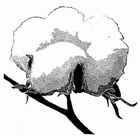Eastley Must Die!
Not really, but I've been noticing lately that dramatic post titles are all the go.
Tony Eastley was at it again on Friday, making throwaway remarks about "flood" irrigation and comparing it to overhead- and drip- irrigation. I was going to let it slide, but I couldn't resist any longer.
First of all, as far as I know, Rice is the only crop grown in Australia under flood irrigation. The correct term for the form of irrigation under which most cotton in Australia is grown isSurface - Furrow Irrigation.
Flood irrigation is, as the name implies, where the field is flooded to the point where the base of the plants are submerged. Now, although by its nature cotton is keen on a drink, it does not like to be submerged. In fact, it doen't even like the soil to be wet for too long.
Surface Furrow Irrigation is a system whereby the field is laser levelled to a uniform slope from one end to the other (usually about 1 in 800 to about 1 in 1500) with a 'head-ditch' across the top. The field is pulled into hills a metre apart and about 450mm high running with the slope. The cotton is planted on the top of the hills and water is run from the 'head-ditch' down the furrows to the 'tail-drain' where it is collected and re-used (it is illegal for water to leave a cotton property once it has been on a paddock, this applies to storm-water run-off as well. A one in five years storm is the bench-mark I think.)
The reason that this method is used is the soil type. A recent seminar I attended had Australia's leading irrigation designer/consultant Jim (The Alternator*) Purcell as one of it's speakers. Jim has worked mainly in the cotton industry, but has worked in Victoria, the Burdekin and Mongolia as well. According to Jim, the soil cotton is mostly grown on in Oz, (Grey cracking clay vertisols for those who are interested) could have been designed for surface furrow irrigation. It has high initial penetration, very low deep drainage, good aeration and very good water retention (It stay moist for a long time, allowing the roots to access the waer.)
I'll continue this later, right now I have to go to work. Remind me to tell you why varying the moisture level is a good thing difficult to achieve with drips or overheads.
Actually, that was one of those "Note to self" things wankers say.
*Alternator = charges even when idling.
Tony Eastley was at it again on Friday, making throwaway remarks about "flood" irrigation and comparing it to overhead- and drip- irrigation. I was going to let it slide, but I couldn't resist any longer.
First of all, as far as I know, Rice is the only crop grown in Australia under flood irrigation. The correct term for the form of irrigation under which most cotton in Australia is grown isSurface - Furrow Irrigation.
Flood irrigation is, as the name implies, where the field is flooded to the point where the base of the plants are submerged. Now, although by its nature cotton is keen on a drink, it does not like to be submerged. In fact, it doen't even like the soil to be wet for too long.
Surface Furrow Irrigation is a system whereby the field is laser levelled to a uniform slope from one end to the other (usually about 1 in 800 to about 1 in 1500) with a 'head-ditch' across the top. The field is pulled into hills a metre apart and about 450mm high running with the slope. The cotton is planted on the top of the hills and water is run from the 'head-ditch' down the furrows to the 'tail-drain' where it is collected and re-used (it is illegal for water to leave a cotton property once it has been on a paddock, this applies to storm-water run-off as well. A one in five years storm is the bench-mark I think.)
The reason that this method is used is the soil type. A recent seminar I attended had Australia's leading irrigation designer/consultant Jim (The Alternator*) Purcell as one of it's speakers. Jim has worked mainly in the cotton industry, but has worked in Victoria, the Burdekin and Mongolia as well. According to Jim, the soil cotton is mostly grown on in Oz, (Grey cracking clay vertisols for those who are interested) could have been designed for surface furrow irrigation. It has high initial penetration, very low deep drainage, good aeration and very good water retention (It stay moist for a long time, allowing the roots to access the waer.)
I'll continue this later, right now I have to go to work. Remind me to tell you why varying the moisture level is a good thing difficult to achieve with drips or overheads.
Actually, that was one of those "Note to self" things wankers say.
*Alternator = charges even when idling.




5 Comments:
That's a very dirty post Dirk. Ho Ho.
Do they still grow cotton up at the Ord River in the Kimberleys? Or did that "Big Scheme" flop on it's face?
I know that a couple of years ago trials resumed, but I think restrictions on chemical use may have killed it off. Colly Farms had a trial of about 340 hectares in 1999 and 2000. They were refused permission to use Endosulfan, a chemical used to control Heliothis, even though the melon-grower next door raised no objections, probably because he was using it himself.
I'll ask around to make sure.
Tony,
did some checking and Monsanto had variety trials of BollgardII last winter and will probably do so again this winter, although the WA environmental lobby is kicking up a fuss. Cotton has been banned altogether in the NT apparently, this would cover the eastern end of the next stage of the Ord River Scheme. The ban is only temporary though, while some consultants pay for their kids' braces.
Don't mention that black soil country - bog city !
Great post mate on the beauty of the stuff, and of the natural slope that country offers cotton. Puts the lie to claims cotton is a free for all.
Met a bloke, ex QQantus pilot turned to cotton, who reckoned he invested $8m on set-up, to return $1m p.a. True or false ? Also, how does dryland cotton, further south, use water ?
JAFA
Your QANTAS mate was probably right - gross, to gross $1m in an average year with reasonable weather, not too much insect pressure and reasonable world prices you need about 200 acres of cotton. It would be highly unusal for anybody to have only 200 acres. My guess is he was up in the Dawson Valley where the topography dictates that sometimes that's all there is. That or down around Hillston. Did he have sheep or cattle as well? Sheep = Hillston, cattle = Dawson Valley, probably.
Dryland cotton is a subject I know very little about. It is grown mainly as an opportunity crop pretty muchg everywhere irrigated cotton is grown, but I have never had anything to do with it.
Post a Comment
<< Home